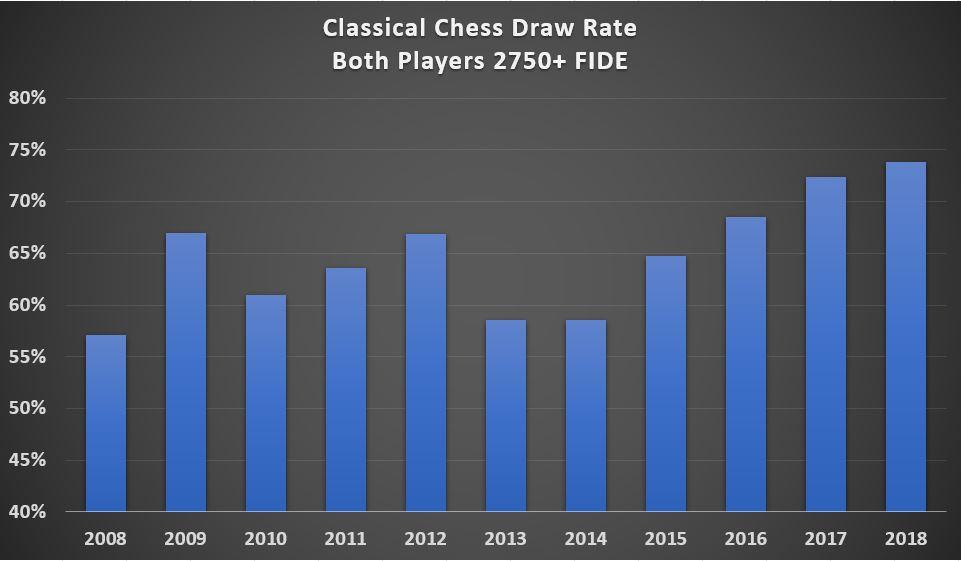
Is Classical Chess Dead From Draws?
The 2018 world chess championship between world champion Magnus Carlsen and the challenger Fabiano Caruana last month saw the top two classical players in the world battle it out in 12 classical chess games. There is always tremendous buzz and excitement heading into a world chess championship match.
The 2018 match made history as the first world championship to end in all classical draws. The 12th and final classical game (video analysis) saw Carlsen offer a draw in a position many thought he should press on for a win. The 13th world champion Garry Kasparov was critical of the draw offer:
In light of this shocking draw offer from Magnus in a superior position with more time, I reconsider my evaluation of him being the favorite in rapids. Tiebreaks require tremendous nerves and he seems to be losing his.
— Garry Kasparov (@Kasparov63) November 26, 2018
In part one of this two-part series, we will explore the draw rate in chess and examine ways to keep the game exciting for spectators.
Data Collection:
Starting with all classical chess games from 2008 until November 30, 2018, we will analyze all games between players with 2750+ FIDE ratings (N=2096 games).
Draw Rate by Year:
The first question to examine is the draw rate by year. It appears the draw rate has ticked up in recent years, but there was a period when the bars seemed to move up and down without any detectable pattern.

Upon closer inspection of the data, the number of classical games between 2750+ FIDE players has risen dramatically over the 2008-2018 time frame. It's not a fair comparison to count each year equally in our analysis.

Another way to look at the draw rate over time is to look at the draw rate moving average in a scatter plot. This will smooth out the plot and allow the eye to pick up trends more easily than the bar chart above.

The increase is much more apparent looking at the moving average plot. Can we just trust our gut and our ruler when it comes to a statistics article?
Statistical Tests:
I'll try not to go too heavy on the stats verbiage since most students are still on winter break. Feel free to send a message or ask in the comments if you'd like further clarification on the stats. Using the programming language "R," we will now test the data to see if there is a linear time trend in the draw rate. We will use a logistic regression on draws (yes/no) to determine if the time variable (YearsSince08) is significant.
> mylogit <- glm(Draw ~ YearsSince08, data = DrawRate, family = "binomial")> summary(mylogit)
A p-value less than 0.05 means the variable is significant. In the model above, the p-value for the time variable is 0.00006, which is highly significant. There does appear to be an increasing trend in the draw rate over the last 10 years.
I also tried running the model adjusting for the average rating of the two players and the difference in rating between the two players. Average rating was not significant, but both difference in rating and the time variable were still significant.
Classical Chess Player Drawishness:
It's possible certain players are the reason for the increasing draw rate. Here are the draw rates of players with over 100 games in the data set. What are your thoughts on the draw rate in classical chess? Stay tuned for part two, where we will take a look at both rapid and blitz time controls.
What are your thoughts on the draw rate in classical chess? Stay tuned for part two, where we will take a look at both rapid and blitz time controls.






